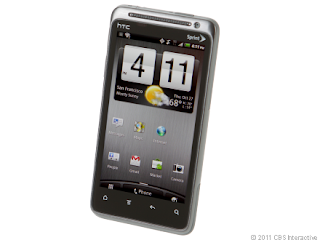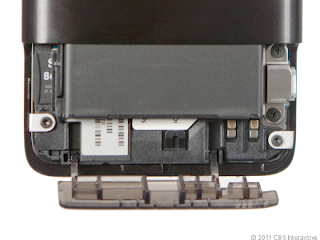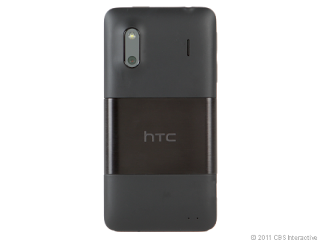The good : The HTC Evo Design 4G has an understated black-on-black design, Android 2.3 Gingerbread, two cameras, and is a world phone. It comes with 8GB of memory preinstalled.
The bad : The stubborn back cover is hard to remove and the speakerphone could be better. A dedicated hardware shutter button wouldn't go amiss.
The bottom line : The HTC Evo Design 4G gives you a lot of smartphone for an excellent value--fast 4G speeds, a good camera, a strong processor, and a sophisticated design. It's an excellent choice for Sprint customers, except those who are specifically looking for a dual-core phone.
The fifth to join the Evo family, the HTC Evo Design 4G is a slightly smaller, more budget-conscious version of the classic Evo 4G and more recent Evo 3D, complete with the family's typical Sprint WiMax 4G speeds. It also has the distinction of being the first globe-trotting Evo, with a GSM-friendly SIM card slot hidden beneath the battery cover (and yes, it will only work overseas.)
HTC might have scaled back with the Design 4G, but that doesn't make it a mediocre phone by any means. The Android 2.3 Gingerbread device has a 1.2GHz processor, a 5-megapixel rear camera, a 1.3-megapixel front-facing camera, and comes with an 8GB microSD card right out of the box. It also has HTC's usual premium finishes and a price point that's hard to beat for all the goodies--just $99.99 with a two-year contract, after a $50 mail-in rebate. Yep, HTC's runtiest Evo is also its best value.
Design
HTC has an eye for design, and from the boxy to the curved, this cell phone maker knows how to make a pretty phone. The answer is yes, the Design 4G has earned its name. The Evo Design 4G pays homage to a lot of other HTC phones, with its boxy edges and wide metallic band across the back. There's also a soft-touch material above and below the band to create a black-on-black tuxedoed look. In fact, it's much more sharp and stylish than the Evo 3D. The Design 4G measures 4.8 inches tall by 2.4 inches wide by 0.47-inch thick and weighs 5.2 ounces (in contrast, the slightly larger Evo 3D stands 5 inches tall by 2.6 inches wide by 0.48-inch thick and weighs 6 ounces.) The size is very manageable and it feels great in the hand and fine on the ear.
The HTC Evo Design 4G is a smidge smaller than
other members of the Evo family, but don't mistake it for a runt.
With the smaller stature comes a smaller screen, a 4-inch rather than a 4.3-inch display. It has a WVGA (960x540-pixel) touch-screen resolution, which isn't the most glorious out there, but it isn't at all bad either. In fact, it looks bright, sharp, and colorful--as it should with support for 16 million hues.
Android 2.3 Gingerbread is running the show backstage on the Evo Design 4G, but HTC's Sense 3.0 is all you see up front. I personally think HTC hit a home run with Sense, everything from its lush graphics to its carousel animation that quickly spins when you swipe your finger fast across the seven customizable home screens.
On to the externals! Below the display are four touch-sensitive navigation buttons to go home, pull up the menu, go back, and search. Above the screen is the 1.3 megapixel camera lens. The right spine is bare; too bad, this would be a great spot for a physical camera shutter button. On the left you'll find the volume rocker and Micro-USB charging port. Up top are the 3.5 millimeter headset jack and the power button. On the back you get the 5-megapixel camera lens and the LED flash.
If you can pry off the back cover, you'll find a microSD card
slot and the GSM SIM slot. Even the internals look chic.
One of the phone's most interesting hardware embellishments is beneath the battery cover, which was tough to wrench off. HTC has even managed to make the guts of the Design 4G look stylish, thanks to a partially transparent hinged ledge that snaps into place below the battery (it's also a structural element that keeps the battery in place. Flip it open, though, and you'll see the SIM slot where you can slide in a GSM SIM card if you take the phone overseas. It bears repeating that the Evo Design 4G will not work with a U.S. GSM SIM.
The microSD card slot is also here below the cover. The phone comes with an 8GB card pre-installed.
Features
Since phones are first and foremost about communications, let's start there. Android on the back end means that the Evo Design 4G lets you access your Google accounts; HTC also hooks in to Facebook contacts if you'd like. The phone supports groups and a host of details per contact. Plus, your available memory is the only limit to the breadth of contacts you can have.
Some extra finishing touches make the square,
black Evo Design 4G more than just a black box.
It's a smartphone, so there's texting, multimedia messaging, e-mail, Bluetooth, Wi-Fi, and GPS on board. HTC Sense lets you access your contact list and messages directly from the lock screen. The Swype virtual keyboard is available, but not by default.















+2013-ps3iso+-+gamebunkerz+blogspot+com.jpg)


0 comments:
Post a Comment